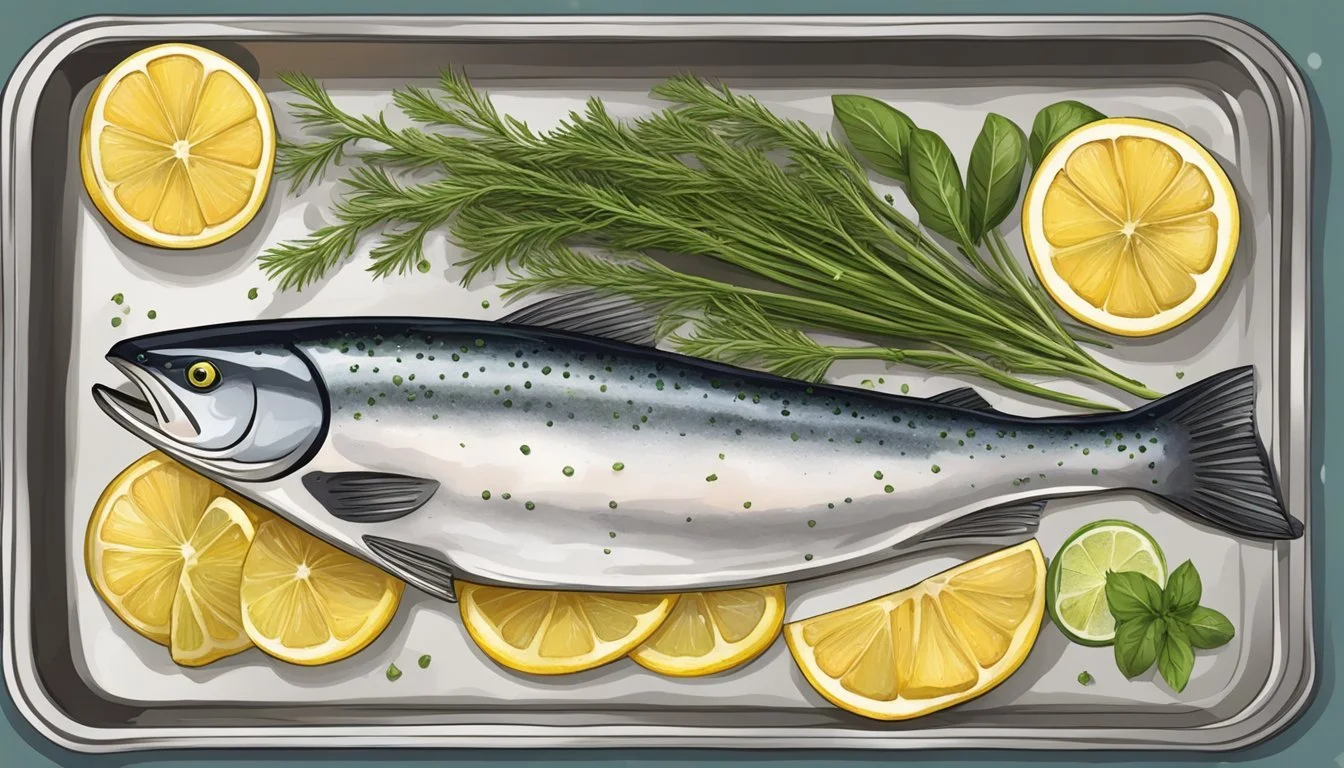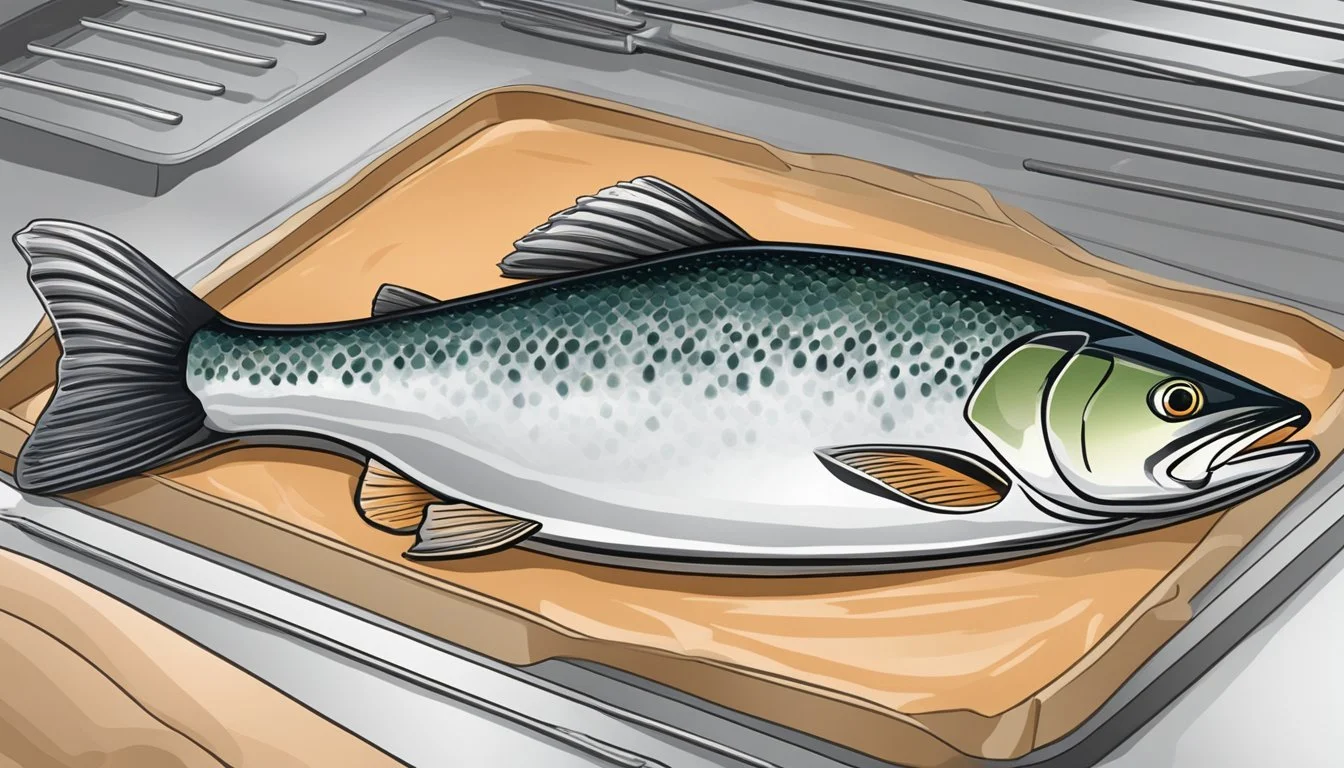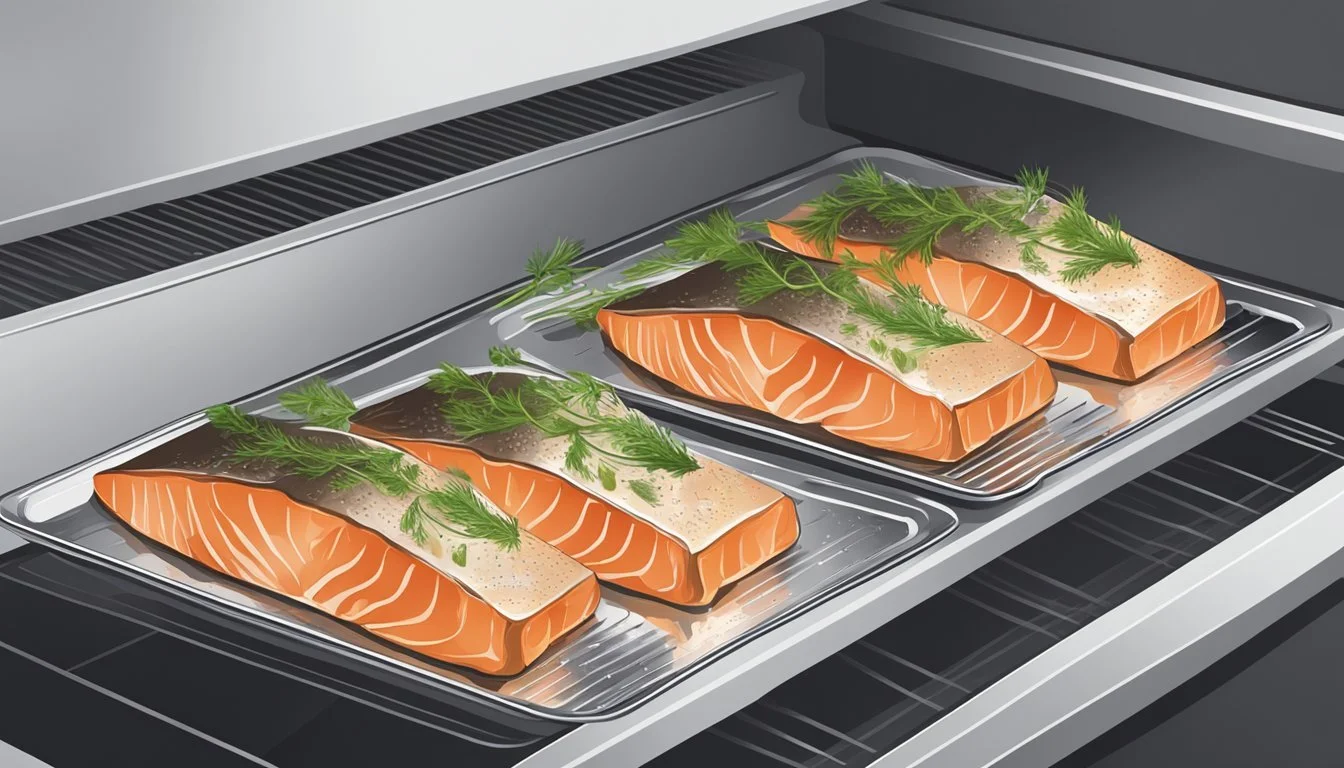How to Cook a 3 lb Salmon Fillet in the Oven
Flaky and Flavorful Results
Cooking a 3-pound salmon in the oven is a simple and delicious way to prepare this nutrient-rich fish. Oven-baked salmon offers a healthier alternative to frying while still delivering moist, flaky results. The key to perfectly baked salmon is preheating the oven to 425°F (218°C) and cooking the fish for approximately 12-15 minutes per pound.
Preparing salmon in the oven allows for easy seasoning and flavor customization. A popular method involves brushing the fillet with a mixture of honey, garlic, and lemon juice before baking. This combination creates a tangy-sweet glaze that complements the natural taste of the salmon. For those seeking a simpler approach, a sprinkle of salt, pepper, and a drizzle of olive oil can enhance the fish's inherent flavors without overpowering them.
Before placing the salmon in the oven, lining the baking sheet with aluminum foil or parchment paper ensures easy cleanup and prevents sticking. Patting the salmon dry with paper towels before seasoning helps achieve a crispy exterior. These small steps contribute to a hassle-free cooking experience and a restaurant-quality result.
Selecting the Perfect Salmon
Choosing the right salmon is crucial for a delicious oven-baked meal. Quality, freshness, and type of salmon all play important roles in the final dish.
Types of Salmon
King salmon, also known as Chinook, is prized for its rich flavor and high fat content. It's ideal for baking due to its moist, tender texture. Atlantic salmon is widely available and offers a milder taste. Sockeye salmon has a vibrant red color and firm texture, perfect for those who prefer a stronger flavor. Coho salmon balances flavor and affordability, making it a popular choice for home cooks.
Freshness and Quality Indicators
Look for salmon with bright, moist skin and firm flesh that springs back when pressed. Avoid fish with a strong fishy odor or discoloration. Fresh salmon should have clear, bulging eyes and red gills. When possible, choose wild-caught salmon for its superior flavor and nutritional profile. Farm-raised options can be good alternatives if sourced from responsible operations.
Importance of Sourcing
Sustainable sourcing ensures the long-term health of salmon populations and ecosystems. Look for certifications like MSC (Marine Stewardship Council) or ASC (Aquaculture Stewardship Council) when purchasing salmon. Local fish markets often provide fresher options and information about the salmon's origin. Consider seasonal availability, as certain types of salmon are at their peak quality during specific months.
Preparation Basics
Proper preparation is crucial for achieving delicious oven-baked salmon. Handling, thawing, and portioning the fish correctly sets the foundation for a successful dish.
Handling and Storage
Store salmon fillets in the refrigerator at 40°F or below. Place them in an airtight container or wrap tightly in plastic wrap to prevent odor transfer. Use fresh salmon within 1-2 days of purchase. For longer storage, freeze salmon at 0°F or below for up to 3 months.
Keep raw salmon separate from other foods to avoid cross-contamination. Always wash hands thoroughly before and after handling raw fish. Use clean cutting boards and utensils dedicated to seafood preparation.
Thawing Techniques
Thaw frozen salmon in the refrigerator for 24-48 hours, depending on size. Place fillets in a covered container on the bottom shelf to catch any drips. For faster thawing, submerge sealed salmon in cold water, changing water every 30 minutes. Never thaw at room temperature.
Microwave thawing is possible but may partially cook the fish. Use the defrost setting in short bursts, checking frequently. Cook thawed salmon immediately for best results and food safety.
Trimming and Portioning
Inspect salmon fillets for any remaining bones and remove with tweezers. Trim excess fat if desired, but leave skin on for easier handling during cooking. For even cooking, portion large fillets into similar-sized pieces, about 4-6 ounces each.
Pat salmon dry with paper towels before seasoning. This helps achieve a crisp exterior when baked. Season with salt and freshly ground black pepper just before cooking to enhance flavor without drawing out moisture.
Seasoning the Salmon
Proper seasoning enhances the natural flavors of salmon, creating a delicious and memorable dish. The right blend of herbs, spices, and aromatics can transform a simple fillet into a culinary masterpiece.
Essential Seasonings
Salt and pepper form the foundation of salmon seasoning. Use kosher salt for its clean taste and coarse texture. Freshly ground black pepper adds a subtle heat. Drizzle olive oil over the salmon to help seasonings adhere and keep the fish moist.
Lemon juice brightens the flavor profile. Squeeze fresh lemon over the salmon just before baking. Minced garlic adds depth and aroma. Mix it with softened butter and spread over the fillet.
For a classic herb combination, sprinkle chopped fresh dill and parsley over the salmon. These herbs complement the fish's natural taste without overpowering it.
Creative Marinades and Rubs
A honey-mustard glaze offers a perfect balance of sweet and tangy. Mix honey, Dijon mustard, and a touch of soy sauce. Brush this mixture over the salmon before baking.
For a smoky flavor, create a rub with brown sugar and paprika. Add a pinch of cayenne pepper for heat. Pat this mixture onto the salmon, pressing gently to adhere.
A teriyaki-inspired marinade combines soy sauce, ginger, and a splash of rice vinegar. Let the salmon soak in this mixture for 30 minutes before cooking.
Balancing Flavors
Combine sweet and savory elements for a well-rounded taste. Brown sugar or maple syrup can balance out saltier ingredients like soy sauce or miso paste.
Acid helps cut through the richness of salmon. Incorporate citrus zest, vinegar, or white wine into marinades.
Herbs add freshness and complexity. Experiment with rosemary, thyme, or cilantro. Use dried herbs sparingly as they're more potent than fresh ones.
Consider textural elements. Finely chopped nuts or breadcrumbs can create a crunchy topping. Mix them with herbs and lemon zest for added flavor.
Oven-Ready Setup
Proper preparation is crucial for perfectly baked salmon. The right cookware and lining choices ensure even cooking and easy cleanup.
Choosing the Right Cookware
A sturdy baking sheet or roasting pan is ideal for cooking a 3 lb salmon fillet. Choose a pan with low sides to allow hot air circulation. Avoid glass dishes, as they can cause uneven cooking. A rimmed aluminum baking sheet works well, distributing heat evenly.
For accurate cooking, use an oven thermometer to verify the oven temperature. Place it near the center of the oven before preheating. This ensures the oven reaches the correct temperature for baking salmon.
Lining Options: Foil vs. Parchment
Lining the baking sheet prevents sticking and simplifies cleanup. Aluminum foil and parchment paper are common options, each with distinct benefits.
Foil conducts heat well, creating a crispy exterior on the salmon. It's also moldable, making it easy to create a packet for steaming. Parchment paper provides a non-stick surface and allows for oil-free cooking. It's best for delicate fish that may stick to foil.
For easy removal, leave an overhang of foil or parchment on the sides of the baking sheet. This creates handles to lift the salmon after cooking.
Cooking the Salmon
Proper cooking technique ensures moist, flavorful oven-baked salmon. The key factors are temperature, timing, and checking for doneness.
Determining Cooking Time
Preheat the oven to 400°F (200°C). Cooking time depends on the salmon's thickness. For a 3-pound fillet, plan on 12-15 minutes per inch of thickness. A 1-inch thick piece will take about 12-15 minutes, while a 1.5-inch thick piece needs 18-22 minutes.
Place the seasoned salmon on a lined baking sheet. Skin-side down works best for even cooking. For extra flavor, add lemon slices or herbs before baking.
Adjust cooking time based on your preferred doneness. Less time yields a softer, more translucent center. Longer baking produces a firmer, more opaque result.
Testing for Doneness
Check the salmon's internal temperature with a meat thermometer. Insert it into the thickest part of the fillet. For medium doneness, aim for 125°F (52°C). For well-done, target 140°F (60°C).
Another method is the fork test. Gently press the tines of a fork into the thickest part. If it flakes easily and separates, it's done. The flesh should be opaque but still moist.
Visual cues also help. Look for a change in color from translucent to opaque pink. The surface should appear slightly firm.
Resting After Baking
Remove the salmon from the oven when it's slightly underdone. It will continue cooking from residual heat. Let it rest for 5-10 minutes before serving.
This resting period allows the juices to redistribute throughout the fillet. It results in a more evenly cooked, moist piece of fish.
Cover the salmon loosely with foil during resting. This helps retain heat and moisture. After resting, the internal temperature will have risen a few degrees.
Serve immediately after resting for the best texture and flavor. The salmon should be flaky, tender, and perfectly cooked throughout.
Complementary Side Dishes
Selecting the right side dishes can elevate your oven-baked salmon to a complete, satisfying meal. The following options offer a range of flavors and textures to complement the rich, flaky fish.
Vegetables and Salads
Roasted asparagus pairs wonderfully with salmon. Toss asparagus spears with olive oil, salt, and pepper, then roast at 400°F for 10-12 minutes. For a refreshing contrast, try a crisp cucumber salad. Slice cucumbers thinly, mix with red onion, and dress with lemon juice and dill.
A Greek salad offers a Mediterranean twist. Combine chopped tomatoes, cucumbers, red onions, and feta cheese. Drizzle with olive oil and sprinkle with oregano.
Grilled zucchini provides a smoky flavor. Cut zucchini into strips, brush with olive oil, and grill for 2-3 minutes per side. Finish with a squeeze of lemon juice.
Starchy Sides: Rice and Potatoes
Lemon herb rice complements salmon beautifully. Cook basmati rice according to package instructions. Stir in lemon zest, chopped parsley, and a pat of butter before serving.
Roasted baby potatoes are simple yet delicious. Toss halved baby potatoes with olive oil, rosemary, and garlic. Roast at 425°F for 20-25 minutes until crispy outside and tender inside.
For a lighter option, try quinoa pilaf. Cook quinoa in vegetable broth, then mix in sautéed onions, garlic, and diced bell peppers. Add toasted almonds for crunch.
Healthy Pairings
Steamed broccoli is a nutritious choice. Steam florets for 5-7 minutes, then toss with lemon juice and a sprinkle of Parmesan cheese.
Roasted sweet potatoes offer a vitamin-rich side. Cut into wedges, toss with olive oil and cinnamon, and roast at 400°F for 25-30 minutes.
A kale and quinoa salad provides a protein boost. Massage chopped kale with lemon juice and olive oil. Mix in cooked quinoa, diced apples, and dried cranberries. Top with a light vinaigrette.
For a low-calorie option, try cauliflower rice. Pulse cauliflower florets in a food processor until rice-like. Sauté with olive oil, garlic, and herbs for 5-7 minutes.
Final Touches and Presentation
The final stages of preparing baked salmon involve enhancing its visual appeal and complementing its flavors. These steps elevate the dish from a simple weeknight meal to an impressive centerpiece.
Garnishing with Fresh Herbs
Fresh herbs add vibrant color and aromatic flavors to baked salmon. Chopped fresh parsley is a classic choice, offering a mild, fresh taste. Sprinkle it generously over the cooked fish just before serving. Dill pairs exceptionally well with salmon, providing a delicate anise-like flavor.
For a pop of color, consider adding thin lemon slices around the salmon. The citrus brightens the dish visually and adds a zesty aroma. A pat of unsalted butter melted over the hot salmon creates a luxurious finish, enhancing the fish's natural richness.
Serving Suggestions
Baked salmon pairs well with a variety of side dishes. Light, fresh salads complement the rich fish. Consider serving it with roasted vegetables for a balanced meal. Steamed broccoli or asparagus make excellent green sides.
For a starch component, roasted potatoes or fluffy rice work well. The salmon's natural oils contain important nutrients like vitamin A, calcium, iron, and potassium. Pairing it with nutrient-dense sides creates a well-rounded, healthful meal.
Presentation is key. Serve the salmon on a large platter, surrounded by colorful vegetables. This family-style approach allows diners to appreciate the entire dish before serving.
Nutrition and Health Information
Salmon is a nutrient-dense fish packed with essential nutrients. A 3-pound salmon typically yields about 6-8 servings.
Per 4-ounce (113g) serving of cooked salmon:
Calories: 200-250
Protein: 22-25g
Total fat: 13-15g
Saturated fat: 3-4g
Cholesterol: 60-70mg
Sodium: 50-60mg
Salmon is an excellent source of high-quality protein and omega-3 fatty acids. These healthy fats support heart and brain health.
The fish also provides vitamin D, B vitamins, and selenium. These nutrients contribute to bone health, energy metabolism, and antioxidant protection.
Salmon contains minimal sugar and carbohydrates. It's naturally low in sodium, making it suitable for low-sodium diets.
For added flavor without excess calories, seasoning salmon with black pepper and herbs is recommended. This enhances taste while keeping the dish healthy.
Baking salmon in the oven helps retain its nutritional value. This cooking method requires little to no added fats, preserving the fish's natural health benefits.
Consuming salmon regularly as part of a balanced diet can contribute to overall health and well-being. Its nutrient profile supports various bodily functions and may help reduce the risk of certain chronic diseases.
Storage and Reheating
Proper storage and reheating techniques are crucial for maintaining the quality and safety of leftover salmon. Following best practices helps preserve flavor and texture while preventing foodborne illness.
Proper Storage for Leftovers
Store cooked salmon in an airtight container in the refrigerator within 2 hours of cooking. Refrigerated salmon stays fresh for up to 3 days. For longer storage, freeze salmon tightly wrapped in plastic wrap and foil for up to 3 months.
Remove any skin before storing to prevent a strong fishy odor. Separate salmon into individual portions for easier reheating later. Label containers with the date to track freshness.
To thaw frozen salmon, transfer it to the refrigerator 24 hours before use. Never thaw at room temperature, as this can allow harmful bacteria to grow.
Best Methods for Reheating
Gentle reheating preserves salmon's delicate texture and flavor. The oven method yields the best results. Preheat to 275°F (135°C) and place salmon on a baking sheet. Cover loosely with foil to retain moisture.
Heat for 10-15 minutes until it reaches an internal temperature of 145°F (63°C). Drizzle with olive oil or lemon juice before reheating to add moisture.
For quicker reheating, use a microwave. Place salmon on a microwave-safe dish, cover with a damp paper towel, and heat in 30-second intervals until warmed through.
Avoid overheating, as this can dry out the fish and make it tough. Let reheated salmon rest for 2-3 minutes before serving to distribute heat evenly.
Additional Tips and Tricks
Mastering the art of baking salmon involves more than just following a recipe. These tips will help you avoid common pitfalls and elevate your dish to restaurant-quality levels.
Avoiding Common Mistakes
Overcooking is a frequent error when baking salmon. Use a meat thermometer to check for doneness—the internal temperature should reach 145°F (63°C) at the thickest part. Remove the salmon from the oven slightly before it reaches this temperature, as it will continue cooking.
Avoid using thin fillets, as they cook too quickly and dry out easily. Opt for thicker cuts or a whole side of salmon for more even cooking.
Pat the salmon dry before seasoning to ensure the spices adhere properly and to promote better browning.
Don't forget to remove pin bones. Run your fingers along the fillet and use tweezers to remove any you find.
Enhancing Flavor and Texture
Marinate the salmon for 30 minutes before baking to infuse it with flavor. A simple mix of olive oil, lemon juice, and fresh herbs works wonders.
Experiment with different seasonings. Try a blend of thyme, oregano, and lemon zest for a Mediterranean twist.
Add a crust to your salmon for extra texture. Mix breadcrumbs with Parmesan cheese and herbs, then press onto the fish before baking.
Boost vitamin C content by serving the baked salmon with a side of citrus salsa or roasted bell peppers.
For a tender, moist result, consider the low and slow method. Bake at 275°F (135°C) for about 30 minutes.
Summary and Closing Thoughts
Baking a 3 lb salmon in the oven is a straightforward process that yields delicious results. With the right techniques, even novice cooks can create a restaurant-quality meal at home.
Quick Recap of Key Points
Preheat the oven to 400°F (200°C) for optimal results. Line a baking sheet with foil for easy cleanup. Place the salmon skin-side down on the sheet. Season the fish with salt, pepper, and any desired herbs or spices.
For a 3 lb salmon, bake for approximately 20-25 minutes. Check for doneness by inserting a fork into the thickest part; it should flake easily. Let the salmon rest for 5 minutes before serving.
Remember to adjust cooking time based on fillet thickness. Thinner portions may cook faster, while thicker cuts might need extra minutes.
Encouragement for Home Cooks
Baking salmon is an excellent choice for a nutritious weeknight dinner. It's a versatile fish that pairs well with various flavors. Don't be afraid to experiment with different seasonings or glazes.
Start with simple recipes and gradually try more complex preparations. Salmon's natural flavor shines through even with minimal seasoning. With practice, you'll develop confidence in your salmon-baking skills.
Keep prep time short by using pre-cut fillets and quick marinades. This makes salmon an ideal option for busy evenings. Enjoy the process of creating a healthful, tasty meal for yourself and your loved ones.









